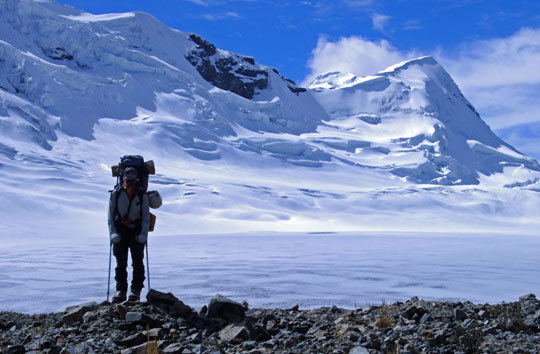
Isabel Suppe on a pre-expedition outing in July. A few days later Suppe, along with Robert Rauch, climbed a new line on Serkhe Khollu (5546m) despite having shattered her foot one year prior. [Photo] Robert Rauch
Isabel: I was finally back in La Paz. After one year of surgeries, hospital stays, physical therapy and a promise from my surgeon that I would never climb again, I had returned into the colorful chaos of La Paz. And I was not merely wandering through that crowd of vegetable-selling cholitas and trout merchants at Mercado Rodriguez; I was once again doing the food shopping for a climbing expedition.
Every winter for several years I had packed up my ice climbing gear, and traveled from my home in Argentina to Bolivia, like a faithful migratory bird. I had climbed most of the classic climbs there. I was ready to move on from the well-traveled climbs, so it had become hard to find a climbing partner. That, and I was still hobbling around on crutches from a climbing accident on Ala Izquierda in the Cordillera Real a year before.
A rope length away from the summit of Ala Izquierda (17,761′), Suppe was pulled from her perch on the summit ridge when her partner fell and ripped out their anchor. They tumbled 400 meters, each severely breaking a leg in the fall. They spent the following two nights above 5000m in the open, trying to crawl back to camp. Her partner died of hypothermia during the second night, and she was rescued the next day.
So one year after the accident, I was ready to climb again and needed someone good to rope up with. I went to see Christian, a gear store owner and friend of mine on Illampu Street. “You need to look up Robert,” he said at once. He was talking about the infamous Robert Rauch, who owns the Cholita restaurant (“La llama que llama”) in Miraflores, and who is also know for opening new, extreme routes such as the south face of Illimani. According to Christian, Robert was a crazy La Paz gringo, and thus the perfect climbing partner for me and my crutches.
Meeting with Robert, I didn’t have to explain much. Robert was well aware of who I was, and he didn’t mind my crutches at all.
Robert: Living at 4000 meters in La Paz, and Isabel having just returned from Cordillera Apolobamba, we didn’t need to acclimatize. The next day we did the food shopping at Mercado Rodriguez, packed our gear and left the following morning. Our objective: the southwest face of Serkhe Khollu (5546m) in Cordillera Real. Despite being just seventeen degrees south of the equator, Cordillera Real is known for its heavy glaciation–a result of its proximity to the moist Amazon lowlands.
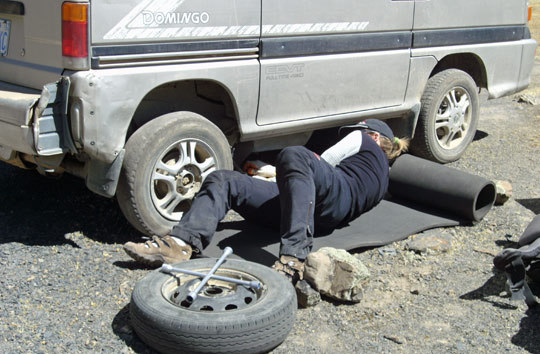
Suppe changes a tire on the “Rauch Mobile” on the way back from Serkhe Khollu. [Photo] Robert Rauch
Construction prevented us from using the normal “road” (a loose definition in Bolivian terms). An abandoned loader stood on the roadside, but we could not find anybody who we could ask for advice. In Bolivia nothing is guaranteed, and anything is possible. Before we gave up on our plan we decided to ask an acquaintance, Hernan Mamani, a llama seller in the village Chincani for advice. He pointed us to an alternative road where my poor, old “Rauch Mobil”–with its dismal shock absorbers–struggled forward, painfully. This road, which hadn’t been a road for quite a while, continued to get worse and we soon got stuck.
Isabel: After several hours of jolting and bumping over the alternative road, we had little faith that we would ever reach the base camp. The road eventually improved to “normally bad” conditions. At dusk we were finishing the set-up of our comfortable base camp.
Robert: Since we got to camp so late, we decide to take a day to carry our technical gear to the bottom of the face. After a sizeable breakfast we left our campsite. Our eyes “climbed” our new route as we walked.
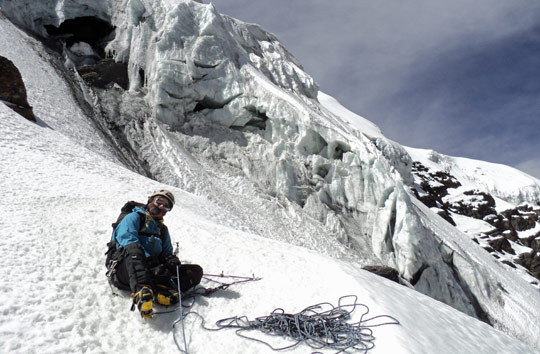
Suppe belays as Rauch approaches the anchor. [Photo] Robert Rauch
Isabel: Around 2:30 a.m. we began the toughest part of our expedition: waking up. The alarm clock’s shrill beeping was undeniable. No matter how hard we tried to banish it from the realm of our dreams, it tirelessly continued screeching.
Robert: We stepped into the night. The air was so cold that our lungs seemed to freeze. After we began to walk we warmed up, and the glacial wind wiped the last bit of sleepiness off our cheeks.
By dawn we reached our cache, and Isabel traded her crutches for ice axes. Most people without injuries wouldn’t make it up here.
At the bottom of the face we set up a belay stance with two nuts, flaked our rope and I was off, leading the first pitch. These first two rope-lengths overlap the crux of Chamaca, a route I put up last year with Stefan Berger and Florian Hill. I stretched them into a single pitch. After sixty meters I built an anchor with two nuts and a friend.
Isabel: The ice was hard as stone, and it was difficult to stick an ice axe with just a single blow behind it. The first ice shower that Robert sent down from above felt quite uncomfortable. During my months of recovery from the accident, “climbing” meant dangling from the fingerboard above my hospital bed. I had become unaccustomed to real climbing. But by the time the third junk of ice smashed against my helmet, I felt just as uncomfortably comfortable as always.
I had told Robert that I wanted to do an easy climb that wouldn’t strain my ankle, having had ten surgeries. I guess that over those past ten years spent in Argentina, I had forgotten that “easy and not strenuous” for Germans means ninety-five-degree waterfalls. Luckily, my foot was holding up very well.
Then it was my turn. At the crux of the pitch I jammed my shoulder behind an icicle to rest. Then I stuck the blade of my ice axe into a small crack fairly high above me, kicked my crampons as high as possible into the ice and pulled myself up on my ice ax. Two more meters of black rock covered with a paper-thin layer of verglass, and we made it, my injured foot and I.
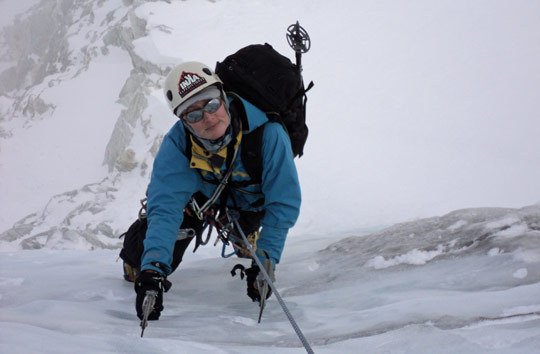
Isabel Suppe [Photo] Robert Rauch
Another pitch of pleasantly hard snow led us to a small plateau where we rested. In front of a majestic blue serac, Robert and I devoured some candy. Another eighty meters of steep, hard snow took us to a rather unpleasant ice traverse to the face’s last great obstacle.
Robert: It was already almost 6 p.m., and we still had one very steep pitch to go before we would reach the summit ridge. Close to the equator the sun sets at 7 p.m. and rises at 7 a.m.
A falling piece of ice smashed against my mouth, and blood began dripping from my lip. I pushed on. A twenty-meter runout brought me to a final overhang. The ice was solid and four swings would take me to the ridge. But I could not continue. The soft snow on the ridge was not consistent enough to hold my axe while I pulled myself up. It felt like the end of a railway line. I was on a dead end track with nowhere to go. I looked back down to the last ice screw. Falling was out of the question. I downclimbed a bit, placed a solid screw and felt instantly better. I braved a traverse to the left so I could pass the cornice. Panting hard, I finally lay on the summit ridge. The wind tore at me and it was nearing dark as Isabel followed my line.
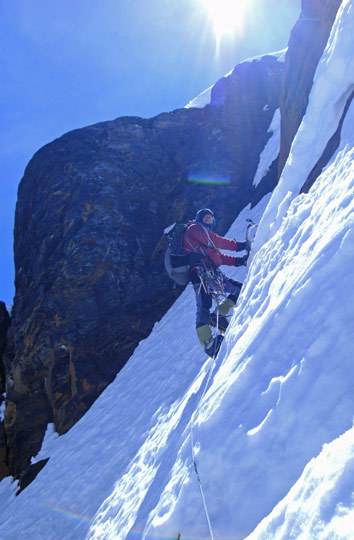
Rauch leads a short, vertical icefall on The Birthday of The Broken Leg (TD+/ED, 500m). [Photo] Isabel Suppe
Isabel: Surrounded by the peaks of the Cordillera Real that were illuminated by the setting sun, I struggled upward over incredibly hard ice. It constantly tried to repel my axes, and my frozen fingers struggled to remove the last ice screw. The wind’s violent strength was menacing, and I couldn’t believe it when I finally gained the summit ridge.
Robert: We had met up with the normal route, and were just a forty-five-minute walk from the summit, but it was a walk I had done so many times before. I knew even before we started that it was a walk we did not want to make.
Isabel: Despite the cold, I took out my camera and we shot a photo. We looked like two bank robbers after a successful heist. “Happy birthday,” Robert said, talking to my broken ankle. Exactly one year ago, Dr. Alejandro Reyes Carrillo pulled my Spantix boot off my ankle. Several bones were sticking out, and I had lost a lot of blood. I had told the doctor that he couldn’t cut my expensive boot because I would need it to climb again.
Shaking from head to toes, but happy, we finally began the descent.
Robert: I was totally frozen. I started stumbling down the summit ridge. Behind me, darkness engulfed everything, interrupted only by the shine of Isabel’s headlamp. She was very optimistic we would find our cache, where we stashed her crutches. I doubted we would. At night, all the stones look the same in this dark expanse.
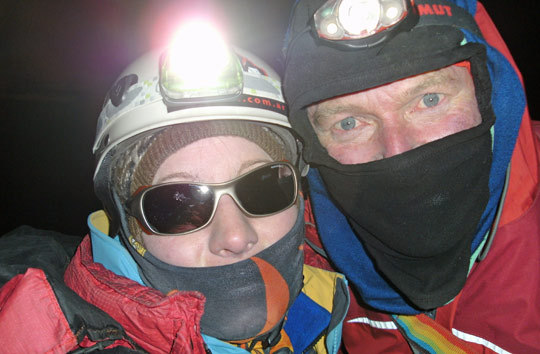
Suppe and Rauch pause at the summit ridge and the top of their new line. “We looked like two bank robbers after a successful heist,” Suppe wrote. [Photo] Isabel Suppe
Isabel: I stayed back to call La Paz so as to let our friends know that we had made it safely off the face, and would be back the following day. Then I followed Robert. At the bottom of the last snowfield we began the “crutch quest.” I didn’t doubt that we would find our cache, simply because we had to find it. I needed my crutches for the descent.
Robert: It was almost as if it had been waiting for us. Our blue potato bag was nestled in a protected hollow. Underneath it were Isabel’s crutches. It had been eighteen hours since we had left our base camp, and we were moving quickly toward the point of exhaustion. We soon got to Lake Sirkhi Khota, but took a wrong turn. We were lost. It was very cold, and I was frozen to the marrow of my bones from the last belay. We couldn’t stay there. There were two options: either find the campsite, or keep on walking in circles to keep warm until we could see the way back. Isabel insisted that we follow the lights of La Paz. I finally agreed, and after a long, dark period of uncertainty we found the trail that took us back to Don Hernan’s hut and our base camp.
Isabel: The mere thought of sitting in the kitchen tent and enjoying a cup of instant cappuccino (which I wouldn’t drink in La Paz even if I were paid for it) made my mouth water. Luckily I was right about our path. After following the lights of La Paz that I remembered having seen from our base camp, we finally see our beautiful tents.
Rauch and Suppe called their line The Birthday of The Broken Leg (TD+/ED), which climbs 500 meters up the southwest face of Serkhe Khollu before meeting with the normal route on the summit ridge. The climb marks the third line up the face after a team of Austrians put up Durch das Nasenloch, a route that is now almost nonexistent because of glacial melting. Rauch, along with Stefan Berger and Florian Hill, also put up Chamaka, which is overlapped by The Birthday of The Broken Leg. Chamaka took the team ten hours, base to summit, and covered 600 meters of up to eighty-five-degree ice. -Ed.
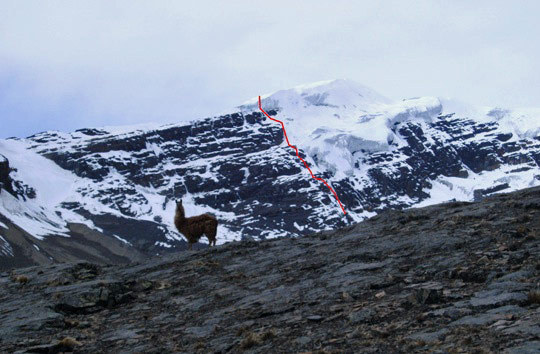
Route line showing The Birthday of The Broken Leg (TD+/ED, 500m), Serke Khollu (5546m), Boliva. The line was established my Robert Rauch and Isabel Suppe on August 1. [Photo] Isabel Suppe
Isabel Suppe is a German writer and mountaineer living in Argentina. She has spent the past eleven years climbing extensively in the Andes, from Colombia to Tierra del Fuego. After her 2010 accident on Ala Izquierda, in which she nearly lost her right foot, Suppe returned to high-altitude mountaineering and began writing her story. Her book, Starry Night, was a finalist for Premio Desnivel, a notable mountain literature award in the international climbing community, and has received a special mention by the jury.
A landscape gardener by trade, Robert Rauch, has worked as a writer, farmer, restaurant owner and mountain guide in Europe and Bolivia. Rauch is based in La Paz, and has completed many notable solos and first ascents in the area, including the route Pacha Brava on Illimani (6438m) and the first solo ascent of the East Wall Pillar on Illampu (6368m).